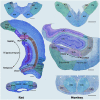Hippocampal - diencephalic - cingulate networks for memory and emotion: An anatomical guide
- PMID: 28944298
- PMCID: PMC5608081
- DOI: 10.1177/2398212817723443
Hippocampal - diencephalic - cingulate networks for memory and emotion: An anatomical guide
Abstract
This review brings together current knowledge from tract tracing studies to update and reconsider those limbic connections initially highlighted by Papez (1937) for their presumed role in emotion. These connections link hippocampal and parahippocampal regions with the mammillary bodies, the anterior thalamic nuclei, and the cingulate gyrus, all structures now strongly implicated in memory functions. An additional goal of this review is to describe the routes taken by the various connections within this network. The original descriptions of these limbic connections saw their interconnecting pathways forming a serial circuit that began and finished in the hippocampal formation. It is now clear that, with the exception of the mammillary bodies, these various sites are multiply interconnected with each other, including many reciprocal connections. In addition, these same connections are topographically organised, creating further subsystems. This complex pattern of connectivity helps to explain the difficulty of interpreting the functional outcome of damage to any individual site within the network. For these same reasons, Papez' initial concept of a loop beginning and ending in the hippocampal formation needs to be seen as a much more complex system of hippocampal-diencephalic-cingulate connections. The functions of these multiple interactions might be better viewed as principally providing efferent information from the posterior medial temporal lobe. Both a subcortical diencephalic route (via the fornix) and a cortical cingulate route (via retrosplenial cortex) can be distinguished. These routes provide indirect pathways for hippocampal interactions with prefrontal cortex, with the preponderance of both sets of connections arising from the more posterior hippocampal regions. These multi-stage connections complement the direct hippocampal projections to prefrontal cortex, which principally arise from the anterior hippocampus, thereby creating longitudinal functional differences along the anterior-posterior plane of the hippocampus.
Keywords: Cingulate cortex; Cingulum; Fornix; Hippocampus; Mammillary bodies; Papez circuit; Parahippocampal cortex; Review; Subiculum; Thalamus.
Conflict of interest statement
Declaration of Conflicting Interests: The Authors declare that there is no conflict of interest.
Figures










References
-
- Aggleton JP. (1986) A description of the amygdalo-hippocampal interconnections in the macaque monkey. Experimental Brain Research 64(3): 515–526. - PubMed
-
- Aggleton JP. (2012) Multiple anatomical systems embedded within the primate medial temporal lobe: Implications for hippocampal function. Neuroscience and Biobehavioral Reviews 36(7): 1579–1596. - PubMed
-
- Aggleton JP, Brown MW. (1999) Episodic memory, amnesia, and the hippocampal-anterior thalamic axis. Behavioral and Brain Sciences 22(3): 425–444. - PubMed
-
- Aggleton JP, Brown MW. (2006) Interleaving brain systems for episodic and recognition memory. Trends in Cognitive Sciences 10(10): 455–463. - PubMed
-
- Aggleton JP, Desimone R, Mishkin M. (1986) The origin, course, and termination of the hippocampothalamic projections in the macaque. Journal of Comparative Neurology 243(3): 409–421. - PubMed
Grants and funding
LinkOut - more resources
Full Text Sources
Other Literature Sources

